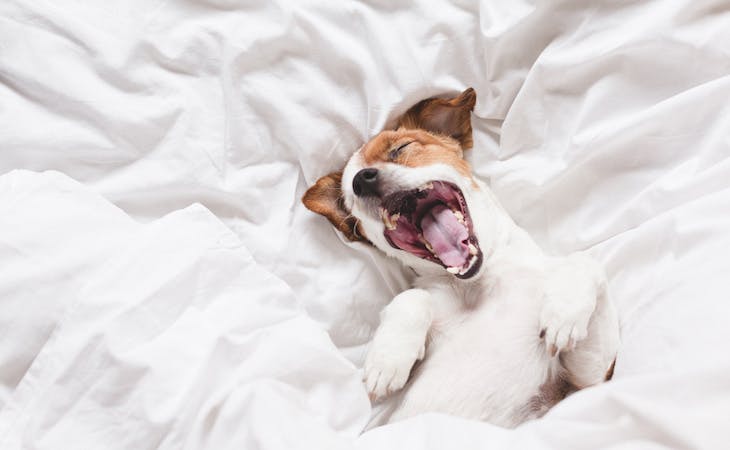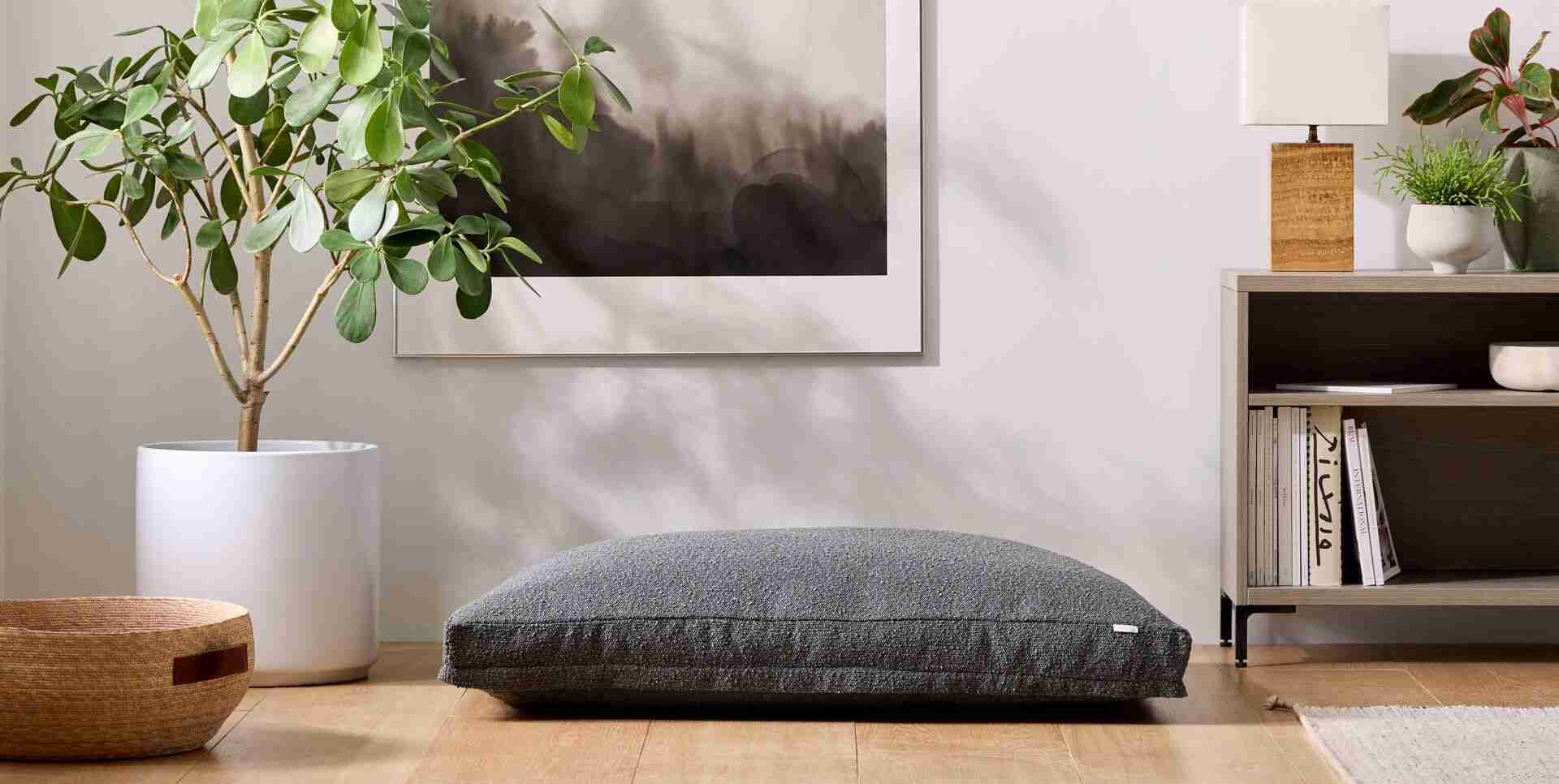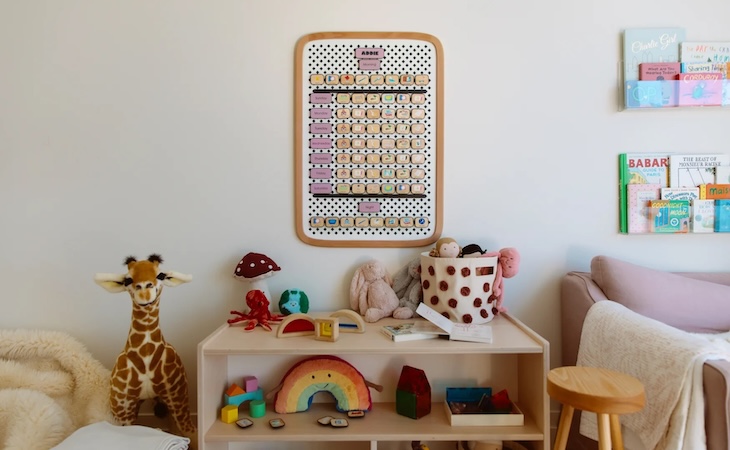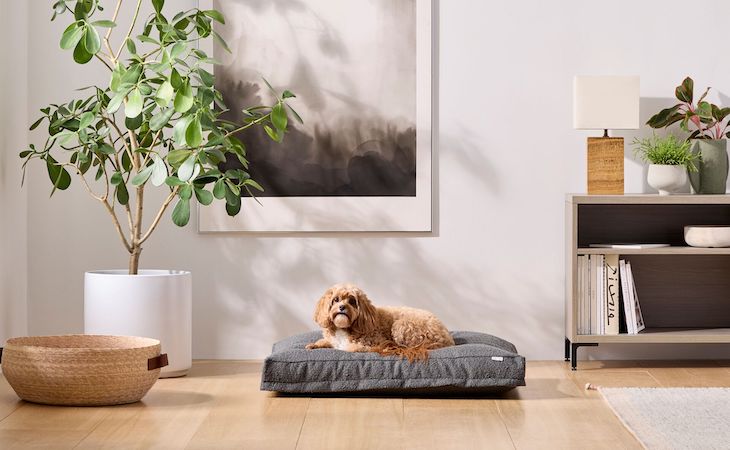Does your dog sleep in the weirdest positions? Mine too. I’ve often wondered how he contorts himself into such fantastical shapes—and what it could possibly mean. So I did a little, um, digging, and discovered that how a dog sleeps reveals more about the animal than you might expect.
Here’s a rundown of the most common sleeping positions and what they can tell us about our canine companions.
Dog sleeping positions and what they mean
Belly-up
My pup will often roll onto his back for a belly rub…and just stay there. Sometimes he falls asleep after a while, to the general bemusement of his humans. But what seems like an uncomfortable position for a dog is in fact a sign of supreme comfort and relaxation.
According to most pet experts, dogs who sleep on their backs feel safe and secure in their surroundings. We know that dogs tend to show their bellies—the most vulnerable part of their bodies—as a sign of submission and trust, and the same applies during sleep. This position is also an effective way of cooling down, since dogs have less fur on their bellies, and some of their sweat glands are located in their paws.
Side snoozing
Like belly-up,” side sleeping is a great way for dogs to beat the heat. My little buddy will collapse like this on a cool part of the floor after spending time in the sun. This position is also a sign of carefree comfort, leaving the dog’s belly partially exposed, which—along with the aforementioned sweat glands—allows him to shed body heat more efficiently. You’ll often see dogs napping or running in their sleep while in this position, which is a sign they’ve entered REM sleep and are dreaming vividly.
The doughnut
One of my favorites. In this position, dogs wrap themselves in a tight loop, with their paws and tail tucked under their snout. Alfred will adopt this position when he really wants some sleep and doesn’t want to be disturbed (and if I try to rouse him too suddenly, he lets me know his displeasure). Dogs curl up this way to conserve body heat, but also to protect their vital organs, an instinct they’ve inherited from their wolfish ancestors, who lived in much less hospitable environments. Dogs will sometimes assume this position in unfamiliar environments, but it doesn’t mean they feel threatened. They’re just trying to create their own little private space of coziness.
Flat-out
Has your puppy ever collapsed in the middle of a play session and taken a snooze on his belly, with limbs outstretched? It’s another good way to cool off on a cold patch of floor. This position also tends to be associated with younger and more active dogs who are ready to spring up at a moment’s notice. I wouldn’t know—my dog is a lazy lump who prefers the couch.
Cuddling with their human
Does your dog like to snuggle up next to you on the couch or in the bed? If so, count yourself very lucky! Dogs are pack animals, and like their wild brethren they prefer to sleep together for safety and warmth. If your dog sees fit to sleep beside you, it’s because he probably views you as a valued member of his pack. (And let’s face it—also because you’re a likely source of belly rubs.) More than half of U.S. pet owners sleep with their pets, but is it a good idea? As we wrote in The Case for Sleeping With Dogs, research says it’s generally fine, as long as they don’t hog half the mattress.
How much sleep do dogs need?
Canine sleep habits are similar in some ways to those of humans. Like us, dogs experience different sleep stages, including REM sleep (in which vivid dreaming usually occurs) and deep sleep. The difference is that a dog spends less time in REM sleep (about 10%) than humans (about 20%). Dogs get more sleep than we do—between 12 and 14 hours a day, on average—but they sleep in shorter bursts. Some experts hypothesize that dogs spend more time asleep to make up for their lower REM rates per sleep episode. (Here’s how much sleep senior dogs need.)
FAQs
What is a dog’s most comfortable sleeping position?
While the belly-up sleeping position seems like an uncomfortable position for a dog, it’s in fact a sign of supreme comfort, relaxation, and safety.
Do dogs like to sleep near their owners?
Dogs enjoy sleeping near their owners and people they trust. They’re pack animals, and like their wild brethren, they prefer to sleep together for safety and warmth. So if your dog sleeps beside you, it’s because they probably view you as a valued member of their pack.
How to make sure your dog gets enough sleep
Sleep is just as important for dogs as it is for humans. Ever hear the old adage, “Let sleeping dogs lie?” Although we’re tempted to pet and cuddle with a snoozing pooch, it’s important to let them sleep uninterrupted. Here are a few ways you can help your dog get some Z’s:
- Create a space where he or she can nestle during daytime naps (even if it’s a favorite chair or spot on the couch).
- Some dogs like to burrow and dig, so consider giving them blankets or bedding for this purpose.
- Make a “den” by putting blankets over their crate.
- Above all, resist the urge to wake them up unless it’s necessary. There will always be time for belly rubs later!
Does your pooch sleep in these or even weirder positions? Show us on Instagram with the hashtag #saatvapets.





